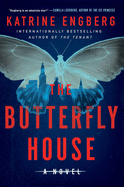
Fans of The Tenant, the first of Katrine Engberg's Kørner and Werner books, will cheer the publication of its finely wrought follow-up, The Butterfly House. However, it's not quite accurate to report that the Copenhagen Police's odd-couple detectives are, as the saying goes, together again. As The Butterfly House opens, Detective Anette Werner is holed up at home, having just had a baby. Not that this stops her from doing what her more rule-abiding partner, Jeppe Kørner, dubs "rogue maternity-leave sleuthing": when Werner learns of a new case from the police radio she has neglected to return to headquarters, she's off and running.
Early one October morning, a corpse is found in Caritas Fountain, in Copenhagen's Old Market Square. Before she was dumped there, the victim--a middle-aged health-care aide--was cut and left to bleed to death. When another body is discovered in a different fountain the following day, it's determined that the victims have more in common than just their killer.
Engberg nimbly integrates two subplots into her main story, which leans on psychological analysis without being ponderous about it. Like The Tenant, The Butterfly House makes terrific use of its setting's cultural institutions and social mores. (Kørner remarks, upon viewing footage of the killer's means of transporting the bodies: "A murderer on a cargo bike, only in Denmark!") The novel's roaming perspective has a thrillingly nerve-racking effect: each time the viewpoint shifts, readers can't help but wonder if this is the character who's going to get it--or give it. --Nell Beram, author and freelance writer

